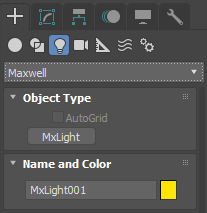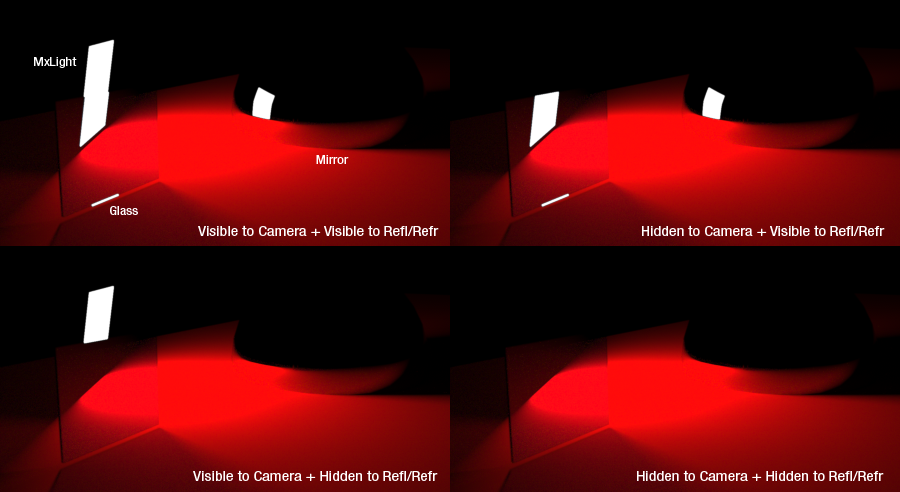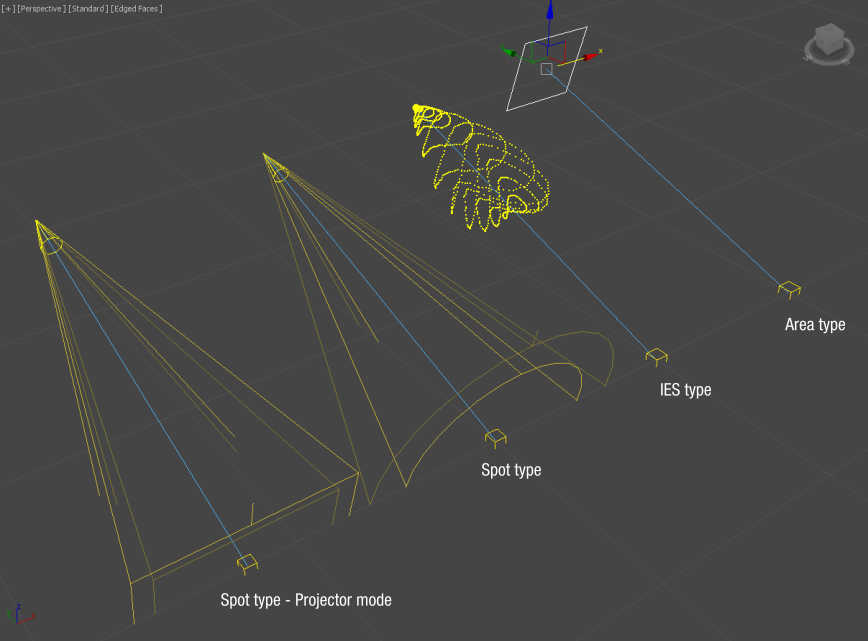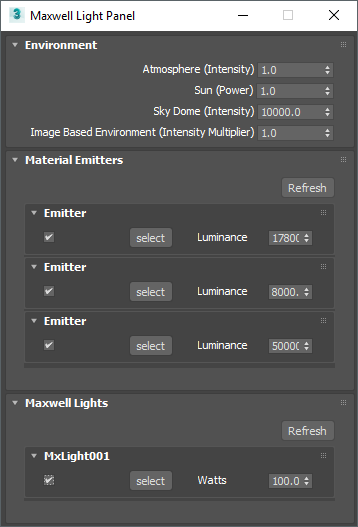...
- Environment lights which include Physical Sky, Constant Dome and Image Based Lighting. You can find the settings regarding environment lights in Render Setup > Renderer tab, in Environment Settings section and Image Based Environment sections.
- You can also illuminate the scene by assigning emitting materials to the objects. This is done by adding an emitter component to any material. You can find more information in the section Lighting with Emitters.
- In order to make things easier for our users, we also created what we call MxLight object, which allows creating Maxwell lights in a similar way as you would do in 3dsmax with conventional spots.
MxLight object
The MxLight object generates the required geometry and material to produce an emitting object and supports the same emitter types as the emitting component of the material: Area, IES and Spot
You will find can create the MxLight object in Create->Lights->Maxwell from the Create → Lights → Maxwell section.
Or using the "Create Maxwell Light" button from the toolbar:
By default, the MxLight is generated with a target an is created by dragging from the emitting object to the target. However, if you disable target checkbox before creating it, you will be able to create the area type by dragging from one corner of the rectangle to the other and in the case of IES or Spot, just by clicking once in the viewport.
...
Creation method with and without a target
All the types have these common options:
...
Demonstration of how using a Ghost BSDF affects MxLight object's shadow and visibility
Examples of how the Hidden to Camera and Hidden to Refl/Refr affect the look of the MxLight
| Info |
|---|
The so-called "Ghost BSDF" can also be created in a normal material. It's a normal BSDF with Transmittance set fully white (255,255,255) and Nd = 1. It renders as air and the rays don't refract when travelling traveling through it, so it's very fast. Click on the thumbnail to see an example: |
Light types
The different types will show different gizmos in the viewport:
Area Type
- The Area type will generate an emitting square of 50x50cm with a target by default. This will only emit light from one side in the direction of the target. The emitting geometry can be converted to a sphere, in which case the target is disabled. Depending on the type of Emission, the options change. It can be by Color, by Temperature or using an image.
...
- Blur feature allows modifying the hardness of the shadows. As you increase its value, the size of the emitting polygon increases, producing softer shadows.
- Projected texture box allows loading an image. In this case, the gizmo of the MxLight will change into a pyramid resembling the proportions of the loaded image and the light will work as a cinema projector. You can project any image format, both low dynamic range images (like jpg, tga or png), high dynamic range images (like hdr, exr or tiff32) or even procedural textures. In this case, the falloff angle grows to the inside of the main cone creating a vignetting effect and darkening the corners of the image.
You can find more information about how Spots work in Maxwell on this page: Spot emitters
Select and Manipulate Mode
All the types allow for some extra controls when you activate "Select and Manipulate" button in 3dsmax.
Depending on the gizmo you can resize, rotate, change the spot angles or modify the intensity of the light. For example, in the Area type, you can resize the plane by dragging from its borders; in the case of the Spot type, you can change the cone or fall-off angles by dragging from the base of the cones.
...
Different options in Select and Manipulate mode
Intensity handle
The intensity handle allows modifying the intensity of the light just by dragging the small box along the light's axis. The small blue dot represents 0 intensity; by default, the manipulator will show 1m away from the blue dot; this represents 10000 lumens. The light changes quadratically to make it easier to select either low or high intensities.
This graphic shows how the light intensity grows quadratically with the distance
Additionally, the color of the intensity handle changes with the color of the light in order to give an idea of how the light will look like.
Maxwell Light Panel
Maxwell Light Panel provides a compact list of all the lights that affect Maxwell with the exception of emitters included in referenced scenes or referenced materials. So it will list first the environment lights (Environment), then the lights based on emitters (Material Lights) and then all the MxLights (Maxwell Lights)
It allows adjusting the light intensities by using the spinners, selecting the material or MxLight and disabling the lights.







